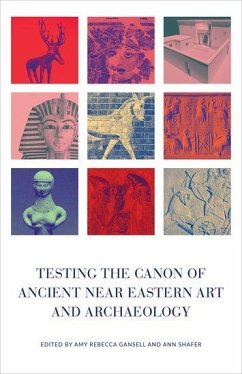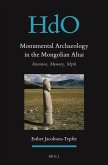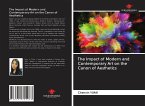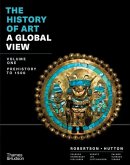Testing the Canon of Ancient Near Eastern Art and Archaeology
Herausgeber: Gansell, Amy; Shafer, Ann
Schade – dieser Artikel ist leider ausverkauft. Sobald wir wissen, ob und wann der Artikel wieder verfügbar ist, informieren wir Sie an dieser Stelle.
Testing the Canon of Ancient Near Eastern Art and Archaeology
Herausgeber: Gansell, Amy; Shafer, Ann
- Gebundenes Buch
- Merkliste
- Auf die Merkliste
- Bewerten Bewerten
- Teilen
- Produkt teilen
- Produkterinnerung
- Produkterinnerung
This book considers the "Greatest Hits" of ancient Near Eastern art and archaeology, including canonical objects, sites, and monuments from Egypt, the Levant, Turkey, Syria, Iraq, and Iran, from the prehistoric era through the Classical period. Gansell, Shafer, and their contributors investigate the factors that have made these historical artifacts so well known for so long. By questioning the canon, this book allows readers to better reflect on the range of ancient Near Eastern culture and revise the canon so it can accommodate new discoveries, represent the values of heritage communities, and remain relevant to contemporary and future audiences.…mehr
Andere Kunden interessierten sich auch für
![Indian Rock Art of the Southwest Indian Rock Art of the Southwest]() Polly SchaafsmaIndian Rock Art of the Southwest43,99 €
Polly SchaafsmaIndian Rock Art of the Southwest43,99 €![We Live in Painting: The Nature of Color in Mesoamerican Art We Live in Painting: The Nature of Color in Mesoamerican Art]() We Live in Painting: The Nature of Color in Mesoamerican Art71,99 €
We Live in Painting: The Nature of Color in Mesoamerican Art71,99 €![Monumental Archaeology in the Mongolian Altai Monumental Archaeology in the Mongolian Altai]() Esther Jacobson-TepferMonumental Archaeology in the Mongolian Altai157,99 €
Esther Jacobson-TepferMonumental Archaeology in the Mongolian Altai157,99 €![The Impact of Modern and Contemporary Art on the Canon of Aesthetics The Impact of Modern and Contemporary Art on the Canon of Aesthetics]() Chenxin YuanThe Impact of Modern and Contemporary Art on the Canon of Aesthetics19,99 €
Chenxin YuanThe Impact of Modern and Contemporary Art on the Canon of Aesthetics19,99 €![The History of Art: A Global View The History of Art: A Global View]() Jean RobertsonThe History of Art: A Global View78,99 €
Jean RobertsonThe History of Art: A Global View78,99 €![Ancient Bronzes of the Eastern Eurasian Steppes Ancient Bronzes of the Eastern Eurasian Steppes]() Emma C BunkerAncient Bronzes of the Eastern Eurasian Steppes63,99 €
Emma C BunkerAncient Bronzes of the Eastern Eurasian Steppes63,99 €![The History of Art: A Global View The History of Art: A Global View]() Jean RobertsonThe History of Art: A Global View143,99 €
Jean RobertsonThe History of Art: A Global View143,99 €
This book considers the "Greatest Hits" of ancient Near Eastern art and archaeology, including canonical objects, sites, and monuments from Egypt, the Levant, Turkey, Syria, Iraq, and Iran, from the prehistoric era through the Classical period. Gansell, Shafer, and their contributors investigate the factors that have made these historical artifacts so well known for so long. By questioning the canon, this book allows readers to better reflect on the range of ancient Near Eastern culture and revise the canon so it can accommodate new discoveries, represent the values of heritage communities, and remain relevant to contemporary and future audiences.
Produktdetails
- Produktdetails
- Verlag: Oxford University Press
- Seitenzahl: 468
- Erscheinungstermin: 3. Februar 2020
- Englisch
- Abmessung: 239mm x 155mm x 30mm
- Gewicht: 907g
- ISBN-13: 9780190673161
- ISBN-10: 0190673168
- Artikelnr.: 57824797
- Herstellerkennzeichnung
- Libri GmbH
- Europaallee 1
- 36244 Bad Hersfeld
- gpsr@libri.de
- Verlag: Oxford University Press
- Seitenzahl: 468
- Erscheinungstermin: 3. Februar 2020
- Englisch
- Abmessung: 239mm x 155mm x 30mm
- Gewicht: 907g
- ISBN-13: 9780190673161
- ISBN-10: 0190673168
- Artikelnr.: 57824797
- Herstellerkennzeichnung
- Libri GmbH
- Europaallee 1
- 36244 Bad Hersfeld
- gpsr@libri.de
Amy Gansell is an Associate Professor of Art History in the Department of Art and Design at St. John's University, where she teaches the first-year global art history survey, as well as courses on ancient and non-Western art, cultural heritage, and museum administration. She received her M.A. and Ph.D. in the History of Art and Architecture from Harvard University, after which she served in a full-time capacity as the Associate Coordinator for Iraqi Cultural Heritage for the U.S. Department of State, and subsequently held a Post-Doctoral Fellowship at Emory University's Bill and Carol Fox Center for Humanistic Inquiry. Gansell has received grants from the Mellon Foundation, the National Endowment for the Humanities (NEH), and The American Academic Research Institute in Iraq (TAARI), and her work has been published in peer-reviewed journals, including the American Journal of Archaeology, Cambridge Archaeological Journal, and the Journal of Archaeological Science. She is co-editor of CyberResearch on the Ancient Near East and Neighboring Regions (Brill, 2018) and presently writing a monograph (Oxford University Press) on the aesthetic presence of Neo-Assyrian queens at Nimrud. Her broad, interdisciplinary research interests include art, architecture, archaeology, ethnography, historiography, and the frontiers of the digital humanities. Ann Shafer is an art historian and architect, and is a specialist in Late Assyrian landscape and palace culture. She received her M.A. in Near Eastern Archaeology from the University of Chicago, her M.Arch. from the Rhode Island School of Design, and her Ph.D. in the History of Art and Architecture from Harvard University. Shafer lived and worked for a number of years in the Middle East, and writes on architectural ornament and spatial experience throughout the region, linking the historic and the contemporary. Shafer is also a specialist in artisanal craft, and has worked alongside craftsmen in parts of the Middle East and North Africa on a number of projects. She has also written on various related topics, including traditional design training and the use of artisanal design in sacred space. A key element in her design work is social activism, including the development of design-training programs for women. She is currently teaching in New York and Providence, Rhode Island.
* Acknowledgments
* Contributors
* List of figures
* List of tables
* List of maps
* Shortened forms
* Foreword Irene J. Winter
* Chapter 1: Perspectives on the Ancient Near Eastern Canon: More than
Mesopotamia's Greatest Hits Amy Rebecca Gansell and Ann Shafer
* Boundaries
* Chapter 2: The Southern Levant and the Ancient Near Eastern Canon
Rachel Hallote
* Chapter 3: Archaeological Research in Pre-Classical Syria and the
Canon of Ancient Near Eastern Art and Archaeology Marina Pucci
* Chapter 4: The Past, Present, and Future of the Canon of Ancient
Anatolian Art Susan Helft
* Chapter 5:The Canon of Ancient Iranian Art: From Grand Narratives to
Local Perspectives Henry P. Colburn
* Chapter 6: "Classical" vs. "Ancient" in the Near Eastern Canon: The
Position of Graeco-Roman Art from the Levant, c. 330 BCE-636 CE
Elise A. Friedland
* Typologies
* Chapter 7: Defining the Canon of Funerary Archaeology in the Ancient
Near East Nicola Laneri
* Chapter 8: The Canon of Ancient Near Eastern Glyptic on a Roll:
Leaps, Hurdles, and Goals Diana L. Stein
* Chapter 9: The Canon of Ancient Near Eastern Palaces David Kertai
* Technologies
* Chapter 10: How Ancient and Modern Memory Shapes the Past: A Canon of
Assyrian Memory Davide Nadali
* Chapter 11: Museums as Vehicles for Defining Artistic Canons: The
Case of the Ancient Near East in the British Museum Paul Collins
* Chapter 12: Beyond the Canon: The Future of the Past in Museum
Exhibitions of Ancient Egyptian and Near Eastern Art Rachel P.
Kreiter
* Chapter 13: The Ancient Near Eastern Canon in the University
Classroom, and Beyond: My Colleagues Speak Ann Shafer
* Heritage Perspectives
* Chapter 14: The Lucrative Business of the Cyrus Cylinder:
Commodification of an Iranian Icon Kamyar Abdi
* Chapter 15: Between Hazor and Masada-Iconic archaeological sites as
symbols of collective memories in modern Israeli identities Gideon
Avni
* Chapter 16: Past Resurrections Tamara Chalabi
* Chapter 17: Earth, Rocks, and Blood: A Wandering Home Sargon George
Donabed
* Chapter 18: 6,000 Years Maymanah Farhat
* Chapter 19: Cultural Heritage Attrition in Egypt Monica Hanna
* Chapter 20: Crafting the Ancient Near Eastern Canon: A Personal
Reflection Zena Kamash
* Chapter 21: The Consequences of the Destruction of Syrian Heritage on
the Syrian Identity and Future Generations Youssef Kanjou
* Chapter 22: Contemporary Art and Archaeology in the Arab World Salwa
Mikdadi
* Chapter 23: The Assyrians-Then and Now Ramsen Shamon
* Chapter 24: Bringing the Past to a Living Room Near You: The
Archaeological Heritage of Anatolia on Glass Oya Topçuoglu
* Bibliography
* Contributors
* List of figures
* List of tables
* List of maps
* Shortened forms
* Foreword Irene J. Winter
* Chapter 1: Perspectives on the Ancient Near Eastern Canon: More than
Mesopotamia's Greatest Hits Amy Rebecca Gansell and Ann Shafer
* Boundaries
* Chapter 2: The Southern Levant and the Ancient Near Eastern Canon
Rachel Hallote
* Chapter 3: Archaeological Research in Pre-Classical Syria and the
Canon of Ancient Near Eastern Art and Archaeology Marina Pucci
* Chapter 4: The Past, Present, and Future of the Canon of Ancient
Anatolian Art Susan Helft
* Chapter 5:The Canon of Ancient Iranian Art: From Grand Narratives to
Local Perspectives Henry P. Colburn
* Chapter 6: "Classical" vs. "Ancient" in the Near Eastern Canon: The
Position of Graeco-Roman Art from the Levant, c. 330 BCE-636 CE
Elise A. Friedland
* Typologies
* Chapter 7: Defining the Canon of Funerary Archaeology in the Ancient
Near East Nicola Laneri
* Chapter 8: The Canon of Ancient Near Eastern Glyptic on a Roll:
Leaps, Hurdles, and Goals Diana L. Stein
* Chapter 9: The Canon of Ancient Near Eastern Palaces David Kertai
* Technologies
* Chapter 10: How Ancient and Modern Memory Shapes the Past: A Canon of
Assyrian Memory Davide Nadali
* Chapter 11: Museums as Vehicles for Defining Artistic Canons: The
Case of the Ancient Near East in the British Museum Paul Collins
* Chapter 12: Beyond the Canon: The Future of the Past in Museum
Exhibitions of Ancient Egyptian and Near Eastern Art Rachel P.
Kreiter
* Chapter 13: The Ancient Near Eastern Canon in the University
Classroom, and Beyond: My Colleagues Speak Ann Shafer
* Heritage Perspectives
* Chapter 14: The Lucrative Business of the Cyrus Cylinder:
Commodification of an Iranian Icon Kamyar Abdi
* Chapter 15: Between Hazor and Masada-Iconic archaeological sites as
symbols of collective memories in modern Israeli identities Gideon
Avni
* Chapter 16: Past Resurrections Tamara Chalabi
* Chapter 17: Earth, Rocks, and Blood: A Wandering Home Sargon George
Donabed
* Chapter 18: 6,000 Years Maymanah Farhat
* Chapter 19: Cultural Heritage Attrition in Egypt Monica Hanna
* Chapter 20: Crafting the Ancient Near Eastern Canon: A Personal
Reflection Zena Kamash
* Chapter 21: The Consequences of the Destruction of Syrian Heritage on
the Syrian Identity and Future Generations Youssef Kanjou
* Chapter 22: Contemporary Art and Archaeology in the Arab World Salwa
Mikdadi
* Chapter 23: The Assyrians-Then and Now Ramsen Shamon
* Chapter 24: Bringing the Past to a Living Room Near You: The
Archaeological Heritage of Anatolia on Glass Oya Topçuoglu
* Bibliography
* Acknowledgments
* Contributors
* List of figures
* List of tables
* List of maps
* Shortened forms
* Foreword Irene J. Winter
* Chapter 1: Perspectives on the Ancient Near Eastern Canon: More than
Mesopotamia's Greatest Hits Amy Rebecca Gansell and Ann Shafer
* Boundaries
* Chapter 2: The Southern Levant and the Ancient Near Eastern Canon
Rachel Hallote
* Chapter 3: Archaeological Research in Pre-Classical Syria and the
Canon of Ancient Near Eastern Art and Archaeology Marina Pucci
* Chapter 4: The Past, Present, and Future of the Canon of Ancient
Anatolian Art Susan Helft
* Chapter 5:The Canon of Ancient Iranian Art: From Grand Narratives to
Local Perspectives Henry P. Colburn
* Chapter 6: "Classical" vs. "Ancient" in the Near Eastern Canon: The
Position of Graeco-Roman Art from the Levant, c. 330 BCE-636 CE
Elise A. Friedland
* Typologies
* Chapter 7: Defining the Canon of Funerary Archaeology in the Ancient
Near East Nicola Laneri
* Chapter 8: The Canon of Ancient Near Eastern Glyptic on a Roll:
Leaps, Hurdles, and Goals Diana L. Stein
* Chapter 9: The Canon of Ancient Near Eastern Palaces David Kertai
* Technologies
* Chapter 10: How Ancient and Modern Memory Shapes the Past: A Canon of
Assyrian Memory Davide Nadali
* Chapter 11: Museums as Vehicles for Defining Artistic Canons: The
Case of the Ancient Near East in the British Museum Paul Collins
* Chapter 12: Beyond the Canon: The Future of the Past in Museum
Exhibitions of Ancient Egyptian and Near Eastern Art Rachel P.
Kreiter
* Chapter 13: The Ancient Near Eastern Canon in the University
Classroom, and Beyond: My Colleagues Speak Ann Shafer
* Heritage Perspectives
* Chapter 14: The Lucrative Business of the Cyrus Cylinder:
Commodification of an Iranian Icon Kamyar Abdi
* Chapter 15: Between Hazor and Masada-Iconic archaeological sites as
symbols of collective memories in modern Israeli identities Gideon
Avni
* Chapter 16: Past Resurrections Tamara Chalabi
* Chapter 17: Earth, Rocks, and Blood: A Wandering Home Sargon George
Donabed
* Chapter 18: 6,000 Years Maymanah Farhat
* Chapter 19: Cultural Heritage Attrition in Egypt Monica Hanna
* Chapter 20: Crafting the Ancient Near Eastern Canon: A Personal
Reflection Zena Kamash
* Chapter 21: The Consequences of the Destruction of Syrian Heritage on
the Syrian Identity and Future Generations Youssef Kanjou
* Chapter 22: Contemporary Art and Archaeology in the Arab World Salwa
Mikdadi
* Chapter 23: The Assyrians-Then and Now Ramsen Shamon
* Chapter 24: Bringing the Past to a Living Room Near You: The
Archaeological Heritage of Anatolia on Glass Oya Topçuoglu
* Bibliography
* Contributors
* List of figures
* List of tables
* List of maps
* Shortened forms
* Foreword Irene J. Winter
* Chapter 1: Perspectives on the Ancient Near Eastern Canon: More than
Mesopotamia's Greatest Hits Amy Rebecca Gansell and Ann Shafer
* Boundaries
* Chapter 2: The Southern Levant and the Ancient Near Eastern Canon
Rachel Hallote
* Chapter 3: Archaeological Research in Pre-Classical Syria and the
Canon of Ancient Near Eastern Art and Archaeology Marina Pucci
* Chapter 4: The Past, Present, and Future of the Canon of Ancient
Anatolian Art Susan Helft
* Chapter 5:The Canon of Ancient Iranian Art: From Grand Narratives to
Local Perspectives Henry P. Colburn
* Chapter 6: "Classical" vs. "Ancient" in the Near Eastern Canon: The
Position of Graeco-Roman Art from the Levant, c. 330 BCE-636 CE
Elise A. Friedland
* Typologies
* Chapter 7: Defining the Canon of Funerary Archaeology in the Ancient
Near East Nicola Laneri
* Chapter 8: The Canon of Ancient Near Eastern Glyptic on a Roll:
Leaps, Hurdles, and Goals Diana L. Stein
* Chapter 9: The Canon of Ancient Near Eastern Palaces David Kertai
* Technologies
* Chapter 10: How Ancient and Modern Memory Shapes the Past: A Canon of
Assyrian Memory Davide Nadali
* Chapter 11: Museums as Vehicles for Defining Artistic Canons: The
Case of the Ancient Near East in the British Museum Paul Collins
* Chapter 12: Beyond the Canon: The Future of the Past in Museum
Exhibitions of Ancient Egyptian and Near Eastern Art Rachel P.
Kreiter
* Chapter 13: The Ancient Near Eastern Canon in the University
Classroom, and Beyond: My Colleagues Speak Ann Shafer
* Heritage Perspectives
* Chapter 14: The Lucrative Business of the Cyrus Cylinder:
Commodification of an Iranian Icon Kamyar Abdi
* Chapter 15: Between Hazor and Masada-Iconic archaeological sites as
symbols of collective memories in modern Israeli identities Gideon
Avni
* Chapter 16: Past Resurrections Tamara Chalabi
* Chapter 17: Earth, Rocks, and Blood: A Wandering Home Sargon George
Donabed
* Chapter 18: 6,000 Years Maymanah Farhat
* Chapter 19: Cultural Heritage Attrition in Egypt Monica Hanna
* Chapter 20: Crafting the Ancient Near Eastern Canon: A Personal
Reflection Zena Kamash
* Chapter 21: The Consequences of the Destruction of Syrian Heritage on
the Syrian Identity and Future Generations Youssef Kanjou
* Chapter 22: Contemporary Art and Archaeology in the Arab World Salwa
Mikdadi
* Chapter 23: The Assyrians-Then and Now Ramsen Shamon
* Chapter 24: Bringing the Past to a Living Room Near You: The
Archaeological Heritage of Anatolia on Glass Oya Topçuoglu
* Bibliography








